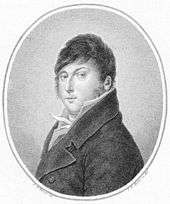Rodolphe Kreutzer

Rodolphe Kreutzer (15 November 1766[1] – 6 January 1831) was a French violinist, teacher, conductor, and composer of forty French operas, including La mort d'Abel (1810).
He is probably best known as the dedicatee of Beethoven's Violin Sonata No. 9, Op. 47 (1803), though he never played the work, declaring it unplayable and incomprehensible. Kreutzer made the acquaintance of Beethoven in 1798, when at Vienna in the service of the French ambassador, Jean-Baptiste Bernadotte (later King of Sweden and Norway).[2] Beethoven originally dedicated the sonata to George Bridgetower, the violinist at its first performance, but after a quarrel he revised the dedication in favour of Kreutzer.
Biography
Life
Kreutzer was born in Versailles, and was initially taught by his German father, who was a musician in the royal chapel, with later lessons from Anton Stamitz. He became one of the foremost violin virtuosos of his day, appearing as a soloist until 1810. He was a violin professor at the Conservatoire de Paris from its foundation in 1795 until 1826. He was co-author of the Conservatoire's violin method with Pierre Rode and Pierre Baillot, and the three are considered the founding trinity of the French school of violin playing. For a time, Kreutzer was leader of the Paris Opera, and from 1817 he conducted there too. He died in Geneva and is buried in Paris at the Père Lachaise Cemetery.
Work
He was well known for his style of bowing, his splendid tone, and the clearness of his execution. His compositions include nineteen violin concertos and forty operas. His best-known works, however, are the 42 études ou caprices (42 Études or Capriccios, 1796) which are fundamental pedagogic studies.
References
- ↑ Académie de Versailles, des Yvelines et de l'Ile-de-France (1909). Revue de l'histoire de Versailles et de Seine-et-Oise (in French). L. Bernard (Versailles); H. Champion (Paris); Bibliothèque nationale de France (online). ISSN 1158-2677.
- ↑ Schwarz, Boris (1958). "Beethoven and the French Violin School". The Musical Quarterly. XLIV (4): 431–447. doi:10.1093/mq/XLIV.4.431.
External links
- Free scores by Rodolphe Kreutzer at the International Music Score Library Project
- Rodolphe Kreutzer at AllMusic
- Rodolphe Kreutzer at Find a Grave